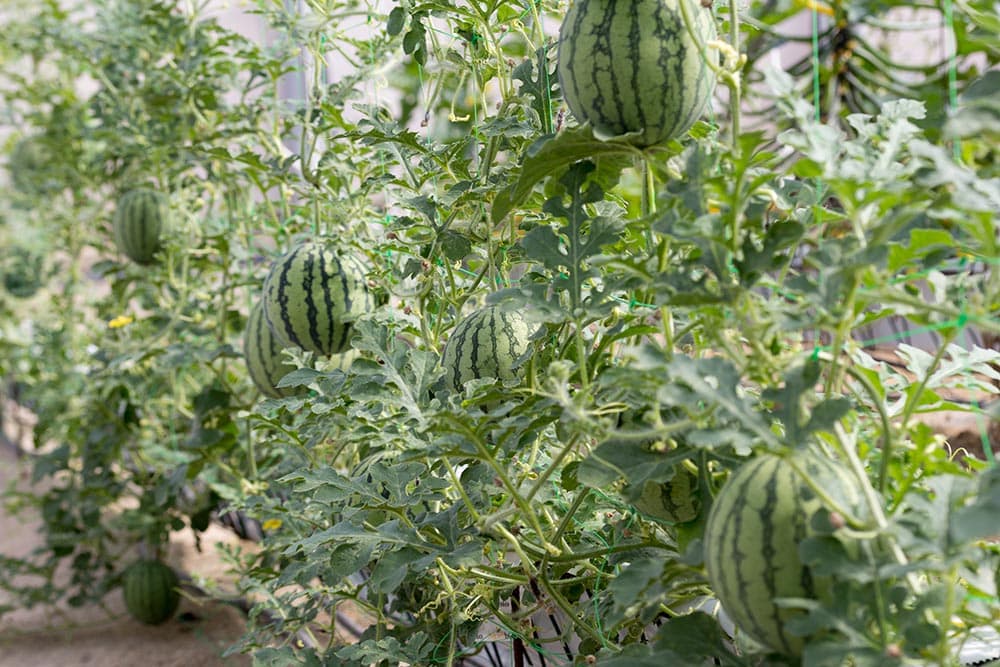Can Watermelon Grow on a Trellis? Steps, Benefits & Companion Plants
-
Shea Cummings
- Last updated:

Watermelons can get quite large—unless we’re talking about those little ornamental watermelons. So, it may come as a surprise to find out that not only can watermelon grow on a trellis, but it can actually be healthier for the plant.
However, the plant will not naturally grow up a trellis by itself, so it needs some human assistance. But once it gets going, you’ll benefit from space savings and some other benefits, which we’ll discuss in this article.
The 3 Steps on How to Grow Watermelon Vertically
Even though it’s not the natural way, it’s not hard to grow a watermelon vertically. It just takes a little bit of extra work. Below we’ll detail the steps you need to take to enjoy a healthy harvest of vertically grown melons.
You really only need three additional things: vertical supports, soft plant ties, and watermelon hammocks.
1. Support
The first thing you need to do is get the support in place that you want the watermelon to grow on. Keep in mind that it needs to be sturdy enough to hold the weight of maturing watermelons.
You can use a sturdy trellis, chain link fencing, chicken coop, etc. As long as it can support the weight of the fruit and has places for the vine to climb, you’re good to go.
2. Encourage the Climb

As the vine grows, it won’t naturally climb the supports like a pea or cucumber will. You’ll have to gently encourage it to do so. This is where the soft ties come into play. You can purchase these from any garden supply center or similar store.
To “train” the vines, all you have to do is gently tie them into place on the support. Ensure that you don’t do this too tightly as that can kill that portion of the vine. Sometimes watermelon vines try to go across the supports instead of up; gentle perseverance is the key.
Keep tying the vine and point it upwards about once a week, and eventually, it’ll take off upward.
3. Supporting the Melons
As the fruit develops on the vine, it won’t need immediate support. However, it’s a good idea to have everything ready. You don’t need anything fancy to make a watermelon hammock—a really common material that’s used is old burlap sacks.
When the watermelon reaches 3–4 inches or approximately the size of your fist, you should begin supporting it. It’s as simple as stringing up a section of burlap between two edges of the support to keep it from pulling down on the vine as it grows.
Symbiotic Relationship Between Chickens and Watermelons
One thing that’s worth pointing out is the symbiotic relationship that a chicken coop and watermelon plants share. If you’re a chicken owner, you probably know that it can be difficult to get anything to grow well around the coop due to the nitrogen-rich soil.
Watermelons thrive in this type of soil, making them a great fit to grow up a chicken coop wire. In addition, chickens don’t particularly like to eat watermelon leaves and typically leave the fruit alone if they can even reach it.
So, if you do have chickens and you’re wondering how you can make better use of the space, try your hand at growing watermelons up the chicken coop fence.
Benefits of Growing Watermelon Vertically
There are several benefits for the plant when you encourage it to grow up on a vertical surface like a trellis, fence, or chicken coop.
- Space savings: Watermelon can spread out a lot, but growing the plant vertically saves a ton of square footage. So vertical growth is an excellent option if you have limited garden space.
- Shade: As the vines grow and spread up the trellis, they begin creating shade. So, if there are shade-loving plants (or animals if you grow them on a chicken coop) beneath the watermelon, they will benefit from the shade.
- Reduced Disease: Being up in the air allows more ventilation for the plants and fruit. This prevents them from sitting in damp soil, making them less susceptible to mold and fungal infections.

Companion Plants to Grow Under the Watermelon
Several plants make great companion plants for watermelon. If you’re looking to try and repel insects and other pests, lavender, marigolds, and alliums have great pest-resisting properties. In addition, basil and mint are two other options that you can put in small containers near the watermelons to help keep pests at bay.
If you’re looking to make the most of the space below your vertical watermelon, shallow root vegetables are great options—carrots or radishes are two possibilities.
Related Reads:
- Do Tomatoes Need a Trellis? How to Grow Tomatoes Vertically
- Do Strawberries Need a Trellis? How to Grow Strawberries Vertically
- Do Raspberries Need a Trellis? How to Grow Raspberries Vertically
Closing Thoughts
It’s definitely a bit of a surprise that watermelons can grow vertically—and do it well! As long as you live in a climate that can grow watermelons and you have the extra time to encourage the vines to climb, give vertical melon growing a shot.
- https://www.hawk-hill.com/watermelon-trellis-chicken-run/
- https://www.gardeningknowhow.com/edible/fruits/watermelon/watermelon-vine-support.htm#:~:text=In%20greenhouses%2C%20supporting%20watermelon%20plants,closer%20to%20the%20light%20source.
- https://homeguides.sfgate.com/grow-watermelons-vertically-22025.html
Featured Image Credit: Deemcat, Pixabay
Contents

